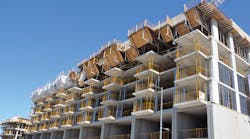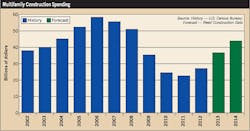Multifamily housing starts and construction spending plunged to historically low levels before rebounding over the last two years. As the economy slid downhill, many single-family homeowners were forced to sell their homes or simply turn them back over to the bank. This led to an uptick in the demand for rental properties and fueled the construction of more multi-family housing units nationwide.
“When people lost their homes in the downturn, others were reluctant to go out and buy single-family housing and chose to rent,” says Bernard Markstein, U.S. chief economist for Reed Construction. “As the demand for multi-family housing increased, however, it was a fixed supply in the short run. The result was that vacancy rates began falling, and rents started rising, which led to new projects.”
Overbuilding, however, is leading to oversupply in some markets. In turn, this is now leading to a slowdown in starts, Markstein says.
“There is a lot of stuff coming on the market all at once in some of the metro areas, and, as a result, it’s tending to hurt rental properties and allowing some of the vacancy rates to creep up,” Markstein says. “The developers are letting the market digest these properties. They will then go back to building again.”
Unlike in the single-family market, in which homeowners need to go to a bank to get a mortgage, developers have a lot of choices when it comes to financing. As such, the multi-family market has fared much better than single-family housing in the recovery and is now close to getting back to normal, Markstein says.
“Multi-family starts are around where they should be based on demographic factors,” Markstein says. “There’s still room for growth, but not a lot at this point.”
After dropping to their lowest level in more than 50 years between 2006 and 2009, multi-family housing starts increased 34% in 2011, according to McGraw Hill Construction, which also forecasted that starts will rise an estimated 19% in 2012 and about 14% this year.
Like housing starts, construction spending is also on the rebound. Spending decreased 30% in 2009, 33% in 2010, and 6% in 2011, but increased about 23% in 2012 and should rise about 35% in 2013 and an estimated 15% in 2014, according to Reed Construction Data (see Chart).
Randy Giggard, managing director of the Research Services Group for FMI in Raleigh, N.C., predicts that the upturn in multi-family housing will last another year-and-a-half, and the associated electrical work will also rise with the tide. Specifically, he’s seeing the most strength in the apartment construction market, especially in the building of upscale apartment communities. He’s also seeing a resurgence of high-rise condos in New York.
“There are a number of different variables at work like demographics and immigration,” Giggard says. “It’s a cyclical market, and we’ll see multi-family slow down again and then single-family pick up.”
Over the years, Giggard has seen a shift in people’s perspectives about what it means to own a single-family home. In addition, the younger generation is often more interested in the amenities of a multifamily structure , such as pools and workout facilities, than the responsibility of owning a home.
“With some of the younger people having seen what has happened to the single-family market over the past six or seven years, they have decided that the single-family home isn’t the long-term investment that it used to be,” Giggard says.
During the slowdown in the economy, many young people may have returned to living back at home or with friends to cut costs, but as they find employment, they will move into their own rental properties, which is a benefit for the multi-family market, Markstein says.
As more young people rent units, developers, in turn, will look to build more apartment complexes to meet their needs. For example, in Florida, this market segment is going strong, says Tom Pritchard, field operations manager for the multi-family department for Tri-City Electrical Contractors, Inc. in Tampa, Fla. The electrical contractor is now working on several large apartment complexes in St. Petersburg, Fla.
“We’ve seen an uptick in construction of multi-family housing since February of this year,” Pritchard says.
These new apartment complexes typically have more units and are built on smaller plots of land, he says. For example, developers used to buy 30 acres to have space for a parking lot. Today, they are buying 15 acres of land, building four- or five-level parking garages in the center, and then constructing the units around them. The apartment buildings are also moving away from the isolated clubhouses and shifting to larger swimming pools and fitness areas, he says.
In addition, the new apartment complexes in Florida are investing in high-tech lighting control systems and installing LED lighting in common areas. They’re also moving to larger electrical services. Many developers are moving away from installing services on the outside of each building. Instead, they are asking Tri-City to help build dedicated electrical rooms with switchboards and switchgear.
“It brings more of the commercial realm into the multi-family housing world,” Pritchard says.
Tri-City, like other electrical contractors, is now enjoying an upturn in the multi-family housing market, and Markstein expects this trend to continue for the near future.
“We have been through a strong period of growth, and I think we are now close to normal and have a healthy level of activity,” he says.
Fischbach is a freelance writer based in Overland Park, Kansas. She can be reached at [email protected].





